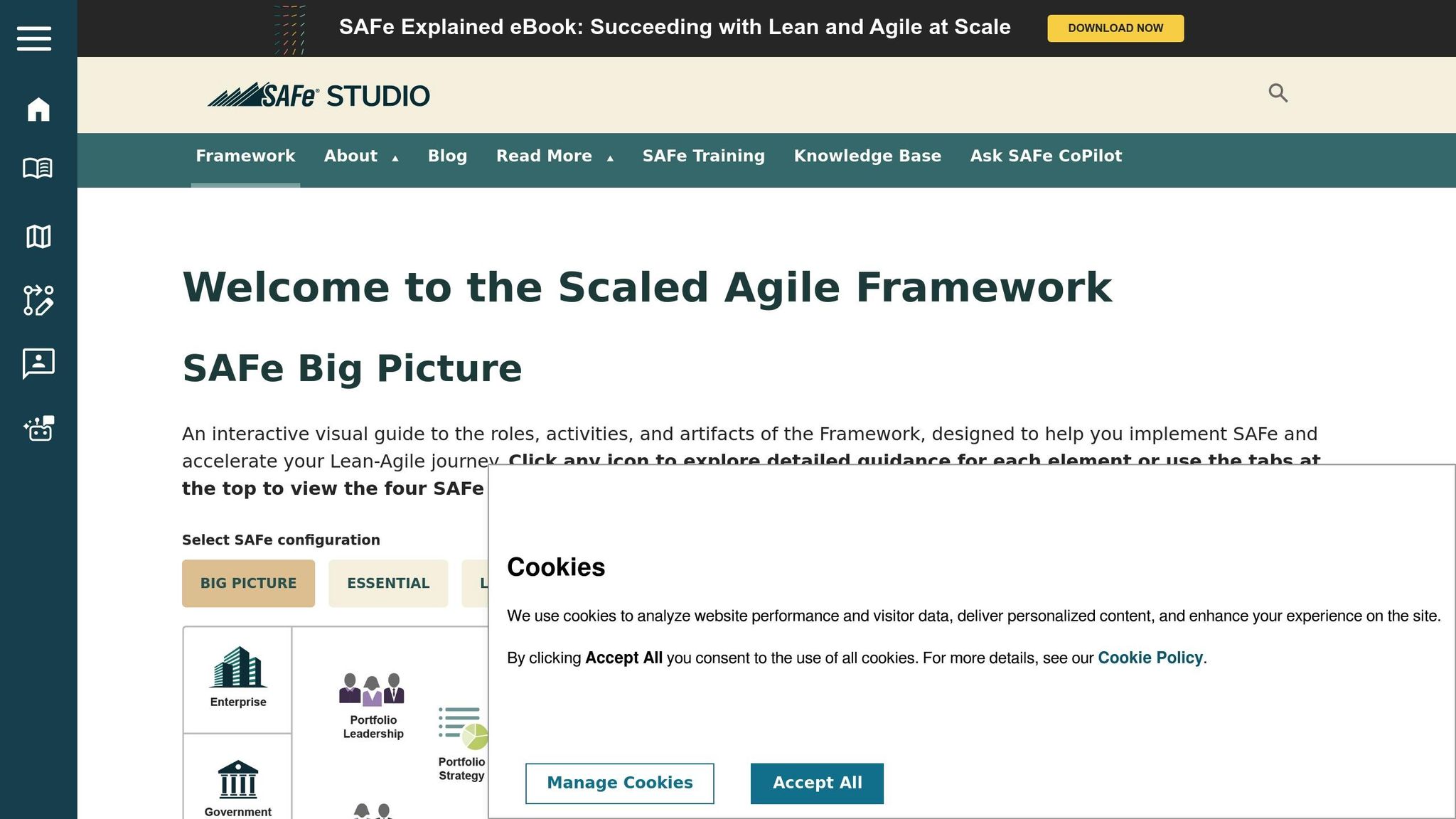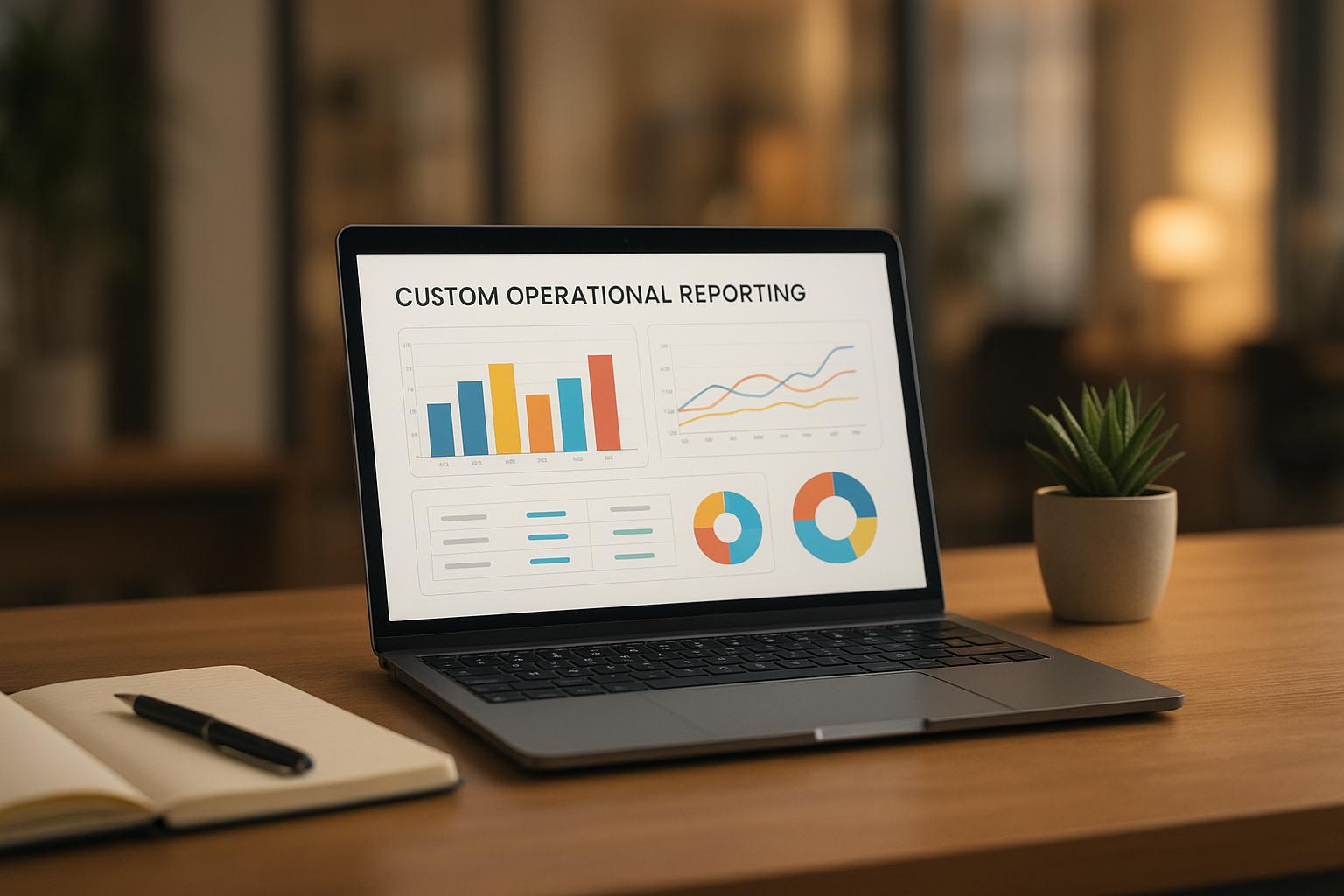Scaling Agile is challenging, especially when it comes to measuring success across teams and aligning efforts with business goals. Traditional Agile metrics like velocity or story points focus on team-level outputs but often miss the bigger picture - business outcomes.
Value Stream KPIs solve this by focusing on outcomes, not just outputs. They link development efforts to strategic goals, helping organizations assess performance across entire value streams. Here's a quick breakdown:
- Focus Areas: Value Stream KPIs emphasize outcomes, flow, and competency.
- Key Metrics: Examples include lead time, customer satisfaction, and flow efficiency.
- Benefits: They enable cross-team alignment, uncover inefficiencies, and tie work to business results.
- Challenges: Implementation can be complex and requires organizational maturity.
Quick Comparison
| Aspect | Value Stream KPIs | Standard Agile Metrics |
|---|---|---|
| Focus | Business outcomes | Team-level performance |
| Scope | Cross-functional, enterprise-wide | Individual teams and sprints |
| Implementation | Complex, long-term impact | Easier, quick feedback |
| Alignment | Strong with strategic goals | Limited without additional frameworks |
| Actionability | Long-term improvements | Immediate team-level adjustments |
Defining Development Value Stream in the SAFe Framework

1. Value Stream KPIs
Value Stream KPIs are designed to measure the performance of value streams in relation to business objectives. Unlike traditional Agile metrics, which focus on team-level activities, these KPIs establish a direct link between development efforts and strategic goals. They help bridge the gap between high-level business themes, Lean Budgeting, Portfolio Kanban epics, and the outcomes driven by portfolios.
Scope of Measurement
The scope of Value Stream KPIs goes beyond individual team performance. SAFe emphasizes three key areas: outcomes, flow, and competency. This approach supports better decision-making and uncovers opportunities for improvement across entire value streams rather than just isolated teams.
SAFe Flow Metrics offer an end-to-end perspective, enabling organizations to identify and address bottlenecks that team-level metrics often overlook. These metrics provide a holistic view of the value stream and help pinpoint where inefficiencies are slowing down product delivery.
For example, in value streams that haven’t been optimized, Flow Efficiency can be surprisingly low. By laying this measurement groundwork, organizations can better assess their business outcomes and focus on meaningful improvements.
Focus on Business Outcomes
The emphasis of Value Stream KPIs is on outcomes rather than outputs. Strategic themes, often expressed as OKRs (Objectives and Key Results), are directly tied to these KPIs, ensuring that every activity measured contributes to broader organizational goals instead of just improving isolated team performance.
Take the case of Company A, a manufacturing firm that implemented Value Stream KPIs in 2024 as part of its Lean Budgeting process. By mapping its value streams and selecting relevant KPIs, the company identified bottlenecks and made targeted improvements. This led to a 25% reduction in lead times, a 50% improvement in defect rates, and a 20% boost in customer satisfaction. These insights helped align teams and enhance efficiency across the board.
Cross-Team Alignment
Value Stream Management (VSM) uses cross-functional teams to eliminate operational silos and provide enterprise-wide visibility. This approach ensures alignment that traditional team-focused metrics often fail to achieve. VSM introduces tools and protocols to create clear, data-driven metrics, offering a comprehensive view of work flow across the organization.
This alignment allows organizations to establish metrics and KPIs that reflect both Agile principles and business objectives. Lean Portfolio Management (LPM) plays a key role here by applying Lean and systems thinking to strategy, investment funding, Agile portfolio operations, and governance. LPM ensures that strategy and execution are aligned, resulting in better business outcomes and faster delivery of innovative solutions.
As Forrester puts it, "Value stream management (VSM) has the potential to completely transform the process of funding, building, managing, and maintaining software at scale". This transformation happens through improved cross-team communication, which enhances the flow of information and value creation.
Actionable Insights
Value Stream KPIs enable organizations to make data-driven decisions and continuously improve by providing a clear picture of how effectively value is being delivered. By tracking these KPIs, businesses can gain deeper insights into their performance and identify areas that need attention.
Value stream mapping is a particularly useful tool for uncovering bottlenecks and pinpointing inefficiencies. Instead of relying on assumptions or incomplete data, teams can take targeted actions to address specific issues.
To maximize the impact of these KPIs, integrate them into Lean Budgeting to guide resource allocation and monitor progress. Use standardized data collection methods and tools, and leverage dashboards to visualize data effectively, promoting informed decision-making.
| KPI Category | Example Metrics | Business Impact |
|---|---|---|
| Flow Metrics | Cycle Time, Lead Time, Flow Efficiency | Faster delivery, reduced bottlenecks |
| Outcome Metrics | Customer Satisfaction, Revenue Impact | Direct measurement of business value |
| Competency Metrics | Team Capability, Process Maturity | Long-term improvement for the organization |
2. Standard Agile Metrics
Standard Agile metrics take a different approach to performance measurement compared to value stream KPIs. While value stream KPIs emphasize end-to-end business outcomes, Agile metrics focus on team-level performance and operational efficiency. These metrics provide quick feedback on team processes, making them essential for day-to-day operations. However, enterprise leaders often combine these metrics with value stream KPIs to ensure they capture the bigger picture.
Scope of Measurement
Standard Agile metrics zoom in on individual teams and projects, targeting specific elements of the software development lifecycle. They track granular activities like sprint performance, task completion rates, and workflow efficiency.
Commonly used metrics include velocity, sprint burndown charts, cycle time, and work-in-progress limits. These tools help teams monitor productivity at various development stages and are particularly useful for sprint planning and operational decision-making.
For example, if a team commits to completing 30 tasks but delivers only nine, their completion rate is 30%. In contrast, a team that commits to 10 tasks and delivers nine achieves a 90% completion rate. This kind of data allows teams to fine-tune their capacity and improve predictability over time.
While these metrics excel at evaluating team-level performance, it's important to consider how well they align with broader business goals.
Focus on Business Outcomes
The primary purpose of standard Agile metrics is to measure operational efficiency rather than strategic impact. These metrics focus on factors like code quality, test coverage (commonly aiming for 80% in the industry), and delivery timelines. However, they don’t necessarily indicate how these improvements affect customer satisfaction or revenue growth.
"The great thing about fact-based decisions is that they overrule the hierarchy." – Jeff Bezos, founder of Amazon
That said, these metrics can serve as a stepping stone for creating more strategic KPIs. For instance, high-performing teams often achieve cycle times of less than a week. When operational excellence like this is aligned with organizational goals, it can contribute to meaningful business outcomes.
Cross-Team Alignment
While Agile metrics provide valuable insights for individual teams, they can fall short when it comes to enterprise-wide coordination. Without a broader framework, these metrics risk siloing teams. Agile frameworks like SAFe address this challenge by introducing planning and reflection cadences across all organizational levels. These cadences ensure that teams stay aligned with the business landscape and work collaboratively toward shared goals.
"SAFe requires lean-agile leadership behavior because only leaders can change the system and create the environment necessary to embrace all of the core values."
A practical example of this alignment comes from a partnership with Motivus. By leveraging AI-driven automation and Agile frameworks, the world’s largest retailer achieved $10 million in operational cost savings, a 15% boost in ROI metrics, a 10% reduction in shipping costs, and a 60% decrease in cash handling errors. Compliance fines dropped by $2 million, and price adjustment times were slashed by 75%.
Actionable Insights
Standard Agile metrics provide teams with immediate, actionable insights for improving their processes. They help set benchmarks, track progress, and evaluate performance across areas like productivity, predictability, and quality. Tools such as Cumulative Flow Diagrams (CFD) are particularly effective for identifying bottlenecks in work-in-progress, enabling teams to act quickly.
To get the most out of these metrics, teams should adopt a balanced mix that offers a comprehensive view of performance. Assigning clear ownership of metrics ensures accountability and accurate tracking. Regularly reviewing these metrics during retrospectives ties insights directly to actionable changes.
While these metrics are vital for improving daily operations, their true potential is realized when they are integrated with broader strategic measures. For organizations scaling Agile practices, combining team-level insights with enterprise-wide KPIs is key to driving optimal results.
sbb-itb-97f6a47
Pros and Cons
Both Value Stream KPIs and Standard Agile Metrics bring their own advantages and challenges to scaled agile environments. Deciding which to prioritize depends on an organization’s goals, level of agile maturity, and the specific outcomes they aim to achieve.
Value Stream KPIs are particularly effective at linking everyday development tasks to broader business objectives. They help close the feedback loop, connecting strategic themes, the Lean Budgeting process, epics from the Portfolio Kanban, and the business outcomes driven by portfolio investments in Development Value Streams. These KPIs provide a comprehensive view, covering areas like time management, budget performance, project completion rates, and customer satisfaction.
However, implementing Value Stream KPIs isn’t always straightforward. Defining and measuring them accurately can be complex. They might not capture every aspect of value delivery, and there’s the risk of manipulating data to present overly favorable results. Additionally, not all value streams across different business units may align well with this approach. With these challenges in mind, it’s helpful to explore how Standard Agile Metrics compare.
Standard Agile Metrics offer quick, actionable insights into sprint performance, workflow efficiency, and bottlenecks. They’re relatively simple to implement, making them a practical choice for teams at various stages of agile adoption.
That said, Standard Agile Metrics have limitations, especially as organizations scale. Without proper context, these metrics can focus too much on activity rather than actual value delivered. They can also make cross-team comparisons more difficult, particularly in larger, more complex organizations.
| Aspect | Value Stream KPIs | Standard Agile Metrics |
|---|---|---|
| Primary Focus | End-to-end business outcomes and strategic goals | Team-level performance and operational tasks |
| Scope | Enterprise-wide, cross-functional value delivery | Individual teams and sprint-level activities |
| Implementation Complexity | High – requires clarity and organizational maturity | Low to Medium – easier to adopt and understand |
| Strategic Alignment | Strong connection to business objectives | Limited without additional frameworks |
| Actionability | Supports long-term strategic improvements | Enables immediate team-level adjustments |
| Risk of Gaming | May be manipulated to show favorable results | Can encourage prioritizing quantity over quality |
| Cross-Team Comparison | Facilitates comparisons across value streams | Difficult to compare across diverse teams |
| Time to Value | Longer to implement but offers lasting impact | Quick wins with immediate feedback |
This side-by-side comparison highlights how each metric type serves distinct purposes, balancing short-term needs with long-term goals. For example, an HP survey revealed that 16% of IT professionals fully embrace agile, 51% lean toward agile practices, and 24% adopt a hybrid approach. This indicates that most organizations find value in combining these metrics to create a more comprehensive performance measurement system.
For organizations just starting their agile journey, Standard Agile Metrics can help establish foundational practices. Over time, as teams mature and scale, Value Stream KPIs can be introduced to align day-to-day work with strategic objectives. Mature organizations often benefit from using both types of metrics in tandem - Standard Agile Metrics for operational efficiency and Value Stream KPIs for strategic guidance.
Ultimately, the metrics chosen should be specific, relevant, timely, transparent, and actionable. Agile principles emphasize continuous improvement over rigid control, so metrics should be tools for growth, not mechanisms for micromanagement.
Conclusion
When comparing Value Stream KPIs to standard Agile metrics, it’s clear both play distinct roles. Agile metrics offer crucial insights at the team level, while Value Stream KPIs bridge daily activities to overarching business objectives. Together, they form a foundation for aligning tactical efforts with strategic outcomes.
As Pearl Zhu, the author of Performance Master, aptly puts it:
"The use of KPIs is meant to improve and transform the organizational performance."
This transformation becomes especially vital as organizations shift focus from isolated team achievements to delivering value across the enterprise. With Value Stream KPIs, every sprint and release can be tied directly to broader strategic goals, ensuring that progress is meaningful at all levels.
Adopting a hybrid approach can be particularly effective. Start with team-level Agile metrics to establish a baseline, and as teams grow and mature, incorporate Value Stream KPIs. This combination provides both immediate feedback and a roadmap for long-term alignment with business priorities.
That said, implementing Value Stream KPIs isn’t without its challenges. Many organizations struggle with defining relevant metrics, setting up solid frameworks, and ensuring cross-functional alignment. This is where agile consultants come in. Their expertise helps organizations navigate these hurdles by crafting metrics that address key areas like team velocity, customer satisfaction, and delivery timelines.
For businesses ready to take this step, resources like the Top Consulting Firms Directory can connect them with experts in digital transformation and agile practices. These consultants not only tailor strategies to meet specific needs but also help identify risks early and provide an external perspective to tackle internal resistance.
Ultimately, scaling agile effectively isn’t just about choosing the right metrics. It’s about creating a system that enables continuous measurement, learning, and adaptation. Value Stream KPIs lay the groundwork for this evolution, while expert guidance ensures the transformation is both impactful and enduring.
FAQs
How do Value Stream KPIs help align teams in a scaled Agile environment?
Value Stream KPIs are essential in a scaled Agile setup because they offer specific, measurable insights into how effectively a value stream meets business objectives. These metrics ensure that all teams are aligned, promoting better coordination and a unified focus throughout the organization.
By connecting strategic objectives to portfolio investments, Value Stream KPIs support decentralized decision-making while keeping everything aligned with the broader business goals. This approach enhances collaboration, builds transparency, and reinforces accountability across teams, ensuring consistent progress toward delivering value.
What challenges do organizations face when implementing Value Stream KPIs, and how can they address them?
Organizations frequently face hurdles like KPIs that fail to align with business priorities, pushback against change, limited collaboration across departments, and difficulty sustaining long-term dedication to value stream efforts. These issues can weaken the impact of Value Stream KPIs and limit their ability to drive real progress.
To address these challenges, companies should prioritize clearly communicating goals, encourage a collaborative team environment, and ensure strong backing from leadership. Taking small, gradual steps can also help generate early successes, building momentum and fostering ongoing enthusiasm and commitment across teams.
How do Value Stream KPIs and Lean Budgeting work together to support better strategic decisions?
Value Stream KPIs and Lean Budgeting
Value Stream KPIs and Lean Budgeting work together to align financial resources with measurable business outcomes. KPIs offer a clear view of how value streams are performing, making it easier for organizations to focus their investments on initiatives that directly support their strategic goals.
This approach ensures funding decisions are grounded in data and centered on results. It helps businesses refine workflows, cut unnecessary steps, and work toward long-term objectives more efficiently. By tying metrics to budgeting, companies can establish a transparent framework for decision-making that promotes both flexibility and accountability.


